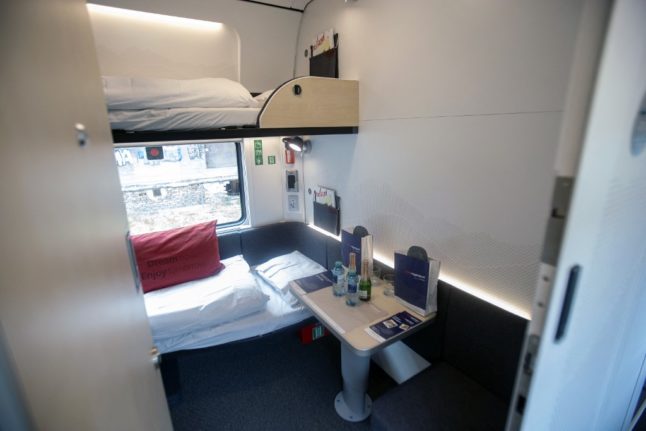For train travel enthusiasts looking for climate-friendly rail travel options between two of the biggest capitals in Europe – it’s been a long nine years. But with night trains making a comeback in Europe, Berlin in particular has been getting several nighttime options in the last year – with a service to Paris potentially being it’s biggest yet.
READ ALSO: Berlin-Paris night train returns after nine years
Who operates this train? Where can I buy a ticket?
The Berlin-Paris night train is operated by Austrian state rail company ÖBB, which will use Mannheim in Germany as a hub for its night train fleet.
With ÖBB operating night services from both Brussels and Paris at one end to Berlin and Vienna on the other, passengers leaving on a Nightjet train from either European capital will board specific train cars assigned for either Berlin or Vienna. It’ll be very important for travellers to board the right car, as they’ll be rearranged in Mannheim with one train taking the Berlin-bound cars north to the German capital and the Vienna-bound cars heading south for the Austrian border.
Europe’s geography ‘kind of reshaped’ as Paris-Berlin night train returns this week: https://t.co/fRFpAeY3Br
— The Man in Seat 61 (@seatsixtyone) December 9, 2023
There’s several different ways you can book a ticket online. French rail SNCF, German state rail DB, and Austrian rail ÖBB all have online booking pages for the Nightjet. ÖBB’s page allows you to purchase from the operator directly and has one of the more user-friendly layouts for comparing prices and your various travel options. However, there are some other travel portals like Rail Europe, Nachtzug (night train), or Trainline where you can also search and book.
READ ALSO: What to know about the new planned cross-border train services between Austria and Germany
How long is the trip and when does it go?
The Berlin to Paris leg of the trip will leave Berlin at 20:18 on Mondays, Wednesdays, and Fridays – before arriving in Paris at 10:24 the next morning.
The train will travel in reverse from Paris to Berlin on Tuesdays, Thursdays, and Saturdays – leaving at 19:12 and arriving in Berlin at 8:26 the next morning.
Depending on the direction, that obviously leaves a travel time of around 13 to 14 hours overnight.
Operators do, however, plan to make Berlin-Paris a nightly service by the end of the year – meaning that people will be able to travel in either direction any day.
KEY POINTS: How Germany’s long-distance train services will change next year
Where else does the train stop?
The Paris to Berlin Nightjet will stop in Halle, Erfurt, Frankfurt, and Strasbourg – in addition to the stop it makes in Mannheim to rearrange cars by destination – depending on whether passengers in the various cars are headed to Paris, Berlin, Brussels, or Vienna.
REVEALED: The best night trains running through Germany
What seat or sleeping options are there available and what do they cost?
There’s three broad categories of places on the train you can book – with each one having a few different sub-categories as well.
You can buy yourself a regular seat, a bunk in a cabin of couchettes, or a full sleeper cabin.
READ ALSO: 6 European cities you can reach from France by high-speed train
Going cheap on a night train – seat options
For seats, you can buy yourself either an individual seat on the train or a private compartment with seats for you and up to two other people. A private compartment will normally have six seats, but the night train will allow only a maximum of three people in each compartment. That way, each person can put their feet up on a second seat.
However, to do this, you need to buy the whole compartment. This will cost at least €100 and could easily be more expensive – depending on how far in advance you book and if you book at a busy time – like a holiday.
An individual seat is your cheapest option – for about €34 minimum. It might be fairly uncomfortable though for a 14-hour, overnight trip.
READ ALSO: Amsterdam-Paris-Berlin rail link likely ‘to come by 2027’
Budget sleeping – couchette bunks
People travelling as a group, particularly families, might find this the easiest option.
You can reserve a full cabin of couchette bunks for a base price of about €200. However, depending on when you’re travelling – this could end up being more expensive. So take care to look for cheaper options on a different day if you have the flexibility, or simply try to book far in advance.
OUI au #traindenuit ! 🌙🚆 pic.twitter.com/q86kC7VgbI
— Clement Beaune (@CBeaune) December 10, 2023
Cheaper individual options will see you shell out at least €50 for a berth in a six-bed cabin or €60 for a spot in a four-bed couchette cabin.
If you reserve a couchette berth, breakfast is included and you’ll get dedicated bed linen.
EXPLAINED: How travelling by train between Berlin and the UK is now easier
Night train travelling in style
For those willing to splurge, there’s a variety of full sleeper car options available to travel in relative comfort.
The cheapest sleeper cars will see you pay a minimum of €80 for a spot in a three-bed sleeper car – or a minimum of €110 for a place in a two-bed sleeper car. Those might, however, be great options for a group of friends or a couple.

Single travellers can shell out a minimum of €160 for a completely private sleeping car.
While all these options include fresh bed linen, breakfast, and a private sink – those willing to part with even more of their money can purchase “Plus” tickets for their triple, double, or single sleeper car spots.
These plus options mean the cabin comes with a private toilet and shower. These Plus options, however, can be considerably more expensive – potentially costing you double what a regular sleeper seat would. If you’re tempted, be sure to check the specific options for the day you want to travel.
READ ALSO: Berlin to get new night train service to Stockholm



 Please whitelist us to continue reading.
Please whitelist us to continue reading.
Not to be all German about it, but we noticed the booking horizon seems to be only about 3 months in advance. So while we’d like to take the Nightjet, it’s untenable when we can book normal train and flight tickets now at a lower price instead of risking waiting for sleeper train availability. It’s a shame!